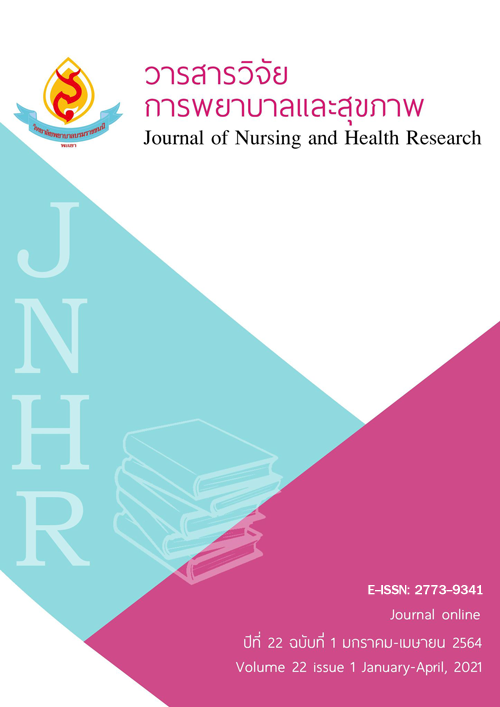ความรู้ การรับรู้ และพฤติกรรมการป้องกันโรคลมร้อนของพลทหารใหม่
คำสำคัญ:
ความรู้, การรับรู้, พฤติกรรม, การป้องกันโรคลมร้อน, พลทหารใหม่บทคัดย่อ
การศึกษานี้เป็นการวิจัยเชิงพรรณนาแบบภาพตัดขวาง มีวัตถุประสงค์เพื่อศึกษา ระดับความรู้ในการป้องกันโรคลมร้อน การรับรู้โอกาสเสี่ยง ความรุนแรง ประโยชน์ และอุปสรรค ในการป้องกันโรคลมร้อน พฤติกรรมการป้องกันโรคลมร้อน และ ปัจจัยที่มีความสัมพันธ์ต่อพฤติกรรมการป้องกันโรคลมร้อน ประชากร คือ พลทหารกองประจำการทหารใหม่ประจำปี 2562 ผลัด 2/2562 ศูนย์การฝึกทหารใหม่ มณฑลทหารบกที่ 35 จังหวัดอุตรดิตถ์ จำนวน 143 นาย เครื่องมือที่ใช้ในการศึกษา คือแบบสอบถามความรู้ และการรับรู้ในการป้องกันโรคลมร้อน พัฒนาโดยผู้วิจัย การวิเคราะห์ข้อมูลใช้สถิติเชิงพรรณา การทดสอบของฟิชเชอร์และค่าสัมประสิทธิ์สหสัมพันธ์เพียร์สัน ผลการวิจัยพบว่า พลทหารใหม่มีความรู้ในการป้องกันโรคลมร้อนอยู่ในระดับมาก (ร้อยละ 60.84) การรับรู้โอกาสเสี่ยง ความรุนแรง ประโยชน์ และอุปสรรค อยู่ในระดับมาก (ร้อยละ 51.75, 42.66, และ 51.75 ตามลำดับ) ทั้งนี้พบ ร้อยละ 53.15 มีพฤติกรรมการป้องกันโรคลมร้อน อยู่ในระดับดี พบว่าประวัติการออกกำลังกายก่อนเป็นทหาร มีความเกี่ยวข้องกับพฤติกรรมการป้องกันโรคลมร้อน อย่างมีนัยสำคัญทางสถิติ การรับรู้ประโยชน์ในการป้องกันโรค การรับรู้ต่ออุปสรรคในการป้องกันโรค การรับรู้โอกาสเสี่ยงในการป้องกันโรค การรับรู้ความรุนแรงในการป้องกันโรค และความรู้ในการป้องกันโรคลมร้อนมีความสัมพันธ์ทางบวกกับพฤติกรรมการป้องกันโรคลมร้อนอย่างมีนัยสำคัญทางสถิติที่ p<.05 (r=.62, .58, .39, .37, และ .24 ตามลำดับ) ดังนั้น หน่วยฝึกทหารควรเน้นการจัดกิจกรรมเพื่อเสริมสร้างการรับรู้ และมุ่งเน้นการปรับเปลี่ยนพฤติกรรมในการป้องกันโรคลมร้อนแก่พลทหารใหม่อย่างเหมาะสม
เอกสารอ้างอิง
กรมอนามัย. (2560). ระบบและกลไกลการเตือนภัยสุขภาพจากความร้อนในระดับชุมชน. สืบค้นเมื่อ 2 มีนาคม 2563, จาก http://hia.anamai.moph.go.th/download/hia/manual/book/book79.pdf.
กรมอนามัย. (2562). คำแนะนำการจัดเตรียม”ศูนย์คลายร้อน”(Cool Room) กรณีภัยความร้อน.สืบค้นเมื่อ 2 มีนาคม 2563, จาก http://hia.anamai.moph.go.th/download/hia/heat/heat60/coolroo m_01.pdf.
กรมอุตุนิยมวิทยา. (2559). อุณหภูมิเดือนเมษายน 2559 ทำลายสถิติของประเทศไทย. สืบค้นเมื่อ 2 มีนาคม 2563, จาก https://www.tmd.go.th/programs/%5Cuploads%5Cweatherclimate%5Capril breakrecord.pdf.
กัญธิภา รอดกลาง. (2551). การจัดการความรู้เพื่อพัฒนาผู้ฝึกทหารใหม่ของหน่วยฝึกทหารใหม่ในพื้นที่จังหวัดพิษณุโลก เกี่ยวกับการปฐมพยาบาลและการป้องกันโรคลมร้อน. (วิทยานิพนธ์ศิลปมหาบัณฑิต). พิษณุโลก. มหาวิทยาลัยราชภัฏพิบูลสงคราม.
ธิติชัย เกาะสมบัติ. (2560). ความสัมพันธ์ของค่าดัชนีมวลกายต่อการเกิดการบาดเจ็บจากความร้อนในการฝึกทหารใหม่ของกองทัพบก. สืบค้นเมื่อ 5 สิงหาคม 2563, จาก http://www.awc.ac.th/awcdata/research/4.pdf.
ณัฐิฏา เทพนรินทร์, อาภรณ์ทิพย์ บัวเพ็ชร์ และแสงอรุณ อิสระมาลัย. (2560). การพัฒนาโปรแกรมป้องกันการบาดเจ็บจากความร้อนของทหารใหม่. วารสารพยาบาลสงขลานครินทร์, 37(4), 69-82.
ปิยฉัตร ลำลึก. (2548). ประสิทธิผลของรูปแบบการเสริมสร้างศักยภาพในการดูแลตนเองเพื่อป้องกันโรคลมร้อนของพลทหารกองประจำการกองพันทหารปืนใหญ่ที่ 722 ค่ายพิบูลสงคราม จังหวัดลพบุรี. (วิทยานิพนธ์วิทยาศาสตร์มหาบัณฑิต สุขศึกษา) กรุงเทพฯ. มหาวิทยาลัยเกษตรศาสตร์.
โรงพยาบาลค่ายพิชัยดาบหัก. (2562). รายงานสถานการณ์โรคลมร้อนหน่วยฝึกทหารใหม่. โรงพยาบาลค่ายพิชัยดาบหัก. อุตรดิตถ์: มณฑลทหารบกที่ 35.
วาสนา นัยพัฒน์, มัลลิกา ลิ้มจิตกร, พัฑฒิดา สุภีสุทธิ์ และ ศิริวรรณ เผ่าจินดา (2557). การคัดกรองปัจจัยเสี่ยง การสำรวจความรู้ และความตระหนักในการป้องกันการเจ็บป่วยจากความร้อนจากการฝึกของทหารกองประจำการ. เวชสารแพทย์ทหารบก, 67(2), 47-58.
ศุภกาญจน์ ผิวเกษแก้ว, สัมมน โฉมฉาย, ณรงค์พณ ทุมวิภาต และดุสิต สุจิรารัตน์. (2562). การเปรียบเทียบค่าดัชนีมวลกายเบื้องต้นที่มัมพันธ์ต่อการเจ็บป่วยจากความร้อนระดับปานกลางถึงรุนแรงในนักเรียนหลักสูตรฝึกทหารของกองทัพเรือ. วารสารแพทย์นาวี, 46(1), 49-65.
สมคิด โพธิ์ชนะพันธุ์. (2560). โรคลมร้อนภาวะฉุกเฉินที่เป็นอันตรายต่อชีวิต. วารสารพยาบาลทหารบก, 18(2), 30-37.
สุวรรณชัย วัฒนายิ่งเจริญชัย. (2563). ป้องกันการป่วยและเสียชีวิตจากโรคลมร้อนหรือฮีทสโตรกโดยเฉพาะเด็กเล็ก ผู้สูงอายุ ผู้ป่วยโรคเรื้อรัง. สืบค้นเมื่อ 2 มีนาคม 2563, จากhttp://msto.dmsc.moph.go.th/login/showimgdetil.php?id=235.
แสงโฉม ศิริพานิช. (2562). สถานการณ์การเฝ้าระวังการป่วยและเสียชีวิตเนื่องจากภาวะอากาศร้อน. สืบค้นเมื่อ 5 สิงหาคม 2563, จาก https://www.udo.moph.go.th/post-to-day-sa/upload.
อริสรา อยู่รุ่ง, อมราภรณ์ หมีปาน, พัชราภรณ์ อุ่นเตจ๊ะ, แอน ไทยอุดม, อุษณีย์ อังคะนาวิน และ สุวีณา เบาะเปลี่ยน. (2557). ปัจจัยที่มีผลต่อพฤติกรรมการเฝ้าระวังป้องกันการเจ็บป่วยเนื่องจากความร้อนของผู้ทำการฝึกพลทหารกองประจำการในกองทัพบก. วารสารพยาบาลทหารบก, 15(1), 114-121.
Becker, M. H. (1974). The health belief model and sick role behavior. In M. H. Becker(Ed.), The health belief model and personal health behavior. Thorofare, NJ: Charles B. Slack.
Best, J. W. (1977). Research in Education. (3rd ed.) Englewood Cliffs, New Jersey: Prentice Hall.
Bloom, B. S. (1971). Handbook on formative and summative evaluation of student learning. New York: McGraw–Hill.
Nutong, R., Mungthin, M., Hatthachote, P., Ukritchon, S., Imjaijit, W., Tengtrakulcharoe, P,...Panichkul., S. (2018). Personal risk factors associated with heat-related illness among new conscripts undergoing basic training in Thailand. Retrieved August 10, 2000, from https://journals.plos.org/plosone/article/authors?id=10.1371/journal.pone.0203428
ดาวน์โหลด
เผยแพร่แล้ว
รูปแบบการอ้างอิง
ฉบับ
ประเภทบทความ
สัญญาอนุญาต
ลิขสิทธิ์ (c) 2021 วารสารวิจัยการพยาบาลและสุขภาพ

อนุญาตภายใต้เงื่อนไข Creative Commons Attribution-NonCommercial-NoDerivatives 4.0 International License.



